
|
Now it is so bright as 7.7 mag (May 4, Marco Goiato). It will approach to the sun down to 0.66 a.u. in July, and it is expected to brighten up to 4-5 mag. Before the perihelion passage, it keeps observable until mid May in the Northern Hemisphere, or until early June in the Southern Hemisphere. After the perihelion passage, it will be observable in excellent condition after late July in the Northern Hemisphere. In the Southern Hemisphere, it keeps unobservable until early September.
Date(TT) R.A. (2000) Decl. Delta r Elong. m1 Best Time(A, h)
May 17 6 59.29 4 9.8 1.429 1.138 52 7.6 20:36 ( 88, 11)
May 24 6 48.89 7 5.9 1.523 1.036 42 7.1 20:44 ( 96, 3)
|

|
It brightened rapidly in outburst in mid October. Now it is bright as 8.4 mag (May 10, Marco Goiato). It keeps 8-9 mag until July. In the Northern Hemishpere, it keeps observable in the morning sky until July. In the Southern Hemisphere, it keeps observable in good condition for a long time until the comet fades out.
Date(TT) R.A. (2000) Decl. Delta r Elong. m1 Best Time(A, h)
May 17 21 56.85 -14 46.6 1.677 1.952 89 8.6 3:16 (311, 24)
May 24 22 6.04 -16 55.4 1.645 2.005 94 8.7 3:09 (314, 24)
|

|
Now it is bright as 8.6 mag (May 3, Carlos Labordena). The brightening is somewhat slow, but it is expected to brighten up to 6-7 mag in 2014 autumn. It keeps observable in good condition for a long time in the Northern Hemisphere. It keeps locating low in the Southern Hemisphere.
Date(TT) R.A. (2000) Decl. Delta r Elong. m1 Best Time(A, h)
May 17 11 54.49 48 5.3 1.517 1.919 96 8.8 20:36 (162, 76)
May 24 11 18.54 45 42.0 1.572 1.837 87 8.7 20:44 (127, 69)
|

|
It passed only 0.4 A.U. from the earth, and 0.8 A.U. from the sun in November and December, and brightened up to 4.7 mag (Nov. 28, Juan Jose Gonzalez). Now it is 11.4 mag (May 4, Carlos Labordena). It keeps observable until 2014 autumn when the comet fades out.
Date(TT) R.A. (2000) Decl. Delta r Elong. m1 Best Time(A, h)
May 17 17 12.26 -19 9.3 1.516 2.478 156 11.1 1:36 ( 0, 36)
May 24 16 56.10 -20 49.7 1.568 2.566 167 11.4 0:53 ( 0, 34)
|
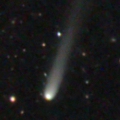
|
Now it is 14.3 mag (Mar. 30, Taras Prystavski). It is expected to brighten up to 7.5 mag and to be observable in excellent condition from summer to autumn in 2014 in the Southern Hemisphere. It keeps observable for a long time in the Southern Hemisphere, although it becomes low temporarily in May. It keeps unobservable for a while in the Northern Hemisphere. It will pass extremely close to Mars in 2014 October.
Date(TT) R.A. (2000) Decl. Delta r Elong. m1 Best Time(A, h)
May 17 2 57.85 -23 16.3 3.233 2.593 43 12.4 3:16 (274,-38)
May 24 3 1.40 -23 14.8 3.112 2.521 46 12.2 3:09 (276,-34)
|
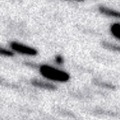
|
The condition in this apparition is bad. It locates low around the brightest days. Now it is not observable. It will appear in the morning sky at 13 mag in late July.
Date(TT) R.A. (2000) Decl. Delta r Elong. m1 Best Time(A, h)
May 17 2 48.31 14 23.3 2.636 1.660 11 12.2 3:16 (241,-14)
May 24 3 8.81 15 27.0 2.623 1.656 13 12.2 3:09 (240,-13)
|

|
Now it is 14.3 mag (May 16, Taras Prystavski). It will approach to the earth down to 0.06 a.u. from May to June, and it is expected to brighten up to 11 mag. In the Northern Hemisphere, it keeps observable in excellent condition until the highlight in late May while the comet will be brightening rapidly. In the Southern Hemisphere, it is not observable now. But it will be observable in mid May. Then it keeps observable in excellent condition at the highlight and after that while the comet will be fading.
Date(TT) R.A. (2000) Decl. Delta r Elong. m1 Best Time(A, h)
May 17 9 28.00 56 22.4 0.132 0.981 73 13.6 20:36 (139, 55)
May 24 10 8.86 35 6.7 0.076 1.002 79 12.4 20:44 ( 97, 57)
|
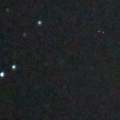
|
Cometary activity began. Now it is bright as 13.5 mag (May 7, A. Novichonok and T. Prystavski). It will brighten up to 7 mag in July, and will be observable in excellent condition in the Northern Hemisphere. In the Southern Hemisphere, it is not observable temporarily in mid July, but it is observable before and after mid July.
Date(TT) R.A. (2000) Decl. Delta r Elong. m1 Best Time(A, h)
May 17 1 9.84 -5 4.9 1.896 1.346 42 13.1 3:16 (272, -6)
May 24 1 9.14 -3 28.3 1.702 1.284 48 12.6 3:09 (274, -1)
|

|
New outburst occured on May 2, and it brightened up to 13.0 mag (May 3, Seiichi Yoshida). Another outburst occured on May 12, and it brightened up to 12.7 mag (May 12, Con Stoitsis).
Date(TT) R.A. (2000) Decl. Delta r Elong. m1 Best Time(A, h)
May 17 15 39.58 -30 34.2 5.147 6.142 168 13.5 0:03 ( 0, 24)
May 24 15 36.04 -30 21.9 5.144 6.140 168 13.5 23:28 ( 0, 25)
|
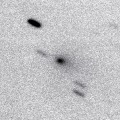
|
It brightened up to 2 mag by unusual major outburst in 2007. It is coming back now. It will be 14 mag at best by normal prediction. But actually, it is already very bright as 13.5 mag (Nov. 25, Hidetaka Sato). Appearing in the morning sky. In the Northern Hemisphere, it keeps observable until it fades out in 2015. In the Southern Hemisphere, it keeps extremely low after this.
Date(TT) R.A. (2000) Decl. Delta r Elong. m1 Best Time(A, h)
May 17 1 16.11 18 25.3 2.874 2.094 32 13.5 3:16 (252, 6)
May 24 1 30.22 20 25.9 2.847 2.105 35 13.6 3:09 (251, 9)
|
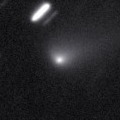
|
Now it is bright as 12.6 mag (May 3, Seiichi Yoshida). It keeps observable at 13 mag in excellent condition from spring to summer.
Date(TT) R.A. (2000) Decl. Delta r Elong. m1 Best Time(A, h)
May 17 13 51.19 -9 15.6 1.628 2.572 153 13.8 22:11 ( 0, 46)
May 24 13 50.01 -8 57.1 1.668 2.571 146 13.8 21:42 ( 0, 46)
|

|
Now it is 15.2 mag (Apr. 7, Katsumi Yoshimoto). It keeps bright as 13-14 mag for a long time from 2013 to 2014.
Date(TT) R.A. (2000) Decl. Delta r Elong. m1 Best Time(A, h)
May 17 21 1.09 -25 23.5 2.641 3.067 105 13.9 3:16 (329, 23)
May 24 21 4.99 -25 34.8 2.556 3.070 111 13.8 3:09 (333, 24)
|

|
Brightened rapidly. Now it is 14.0 mag (Mar. 28, Sandor Szabo). It will brighten up to 13-14 mag and will be observable in excellent condition from spring to summer in the Southern Hemisphere. It locates somewhat low in the Northern Hemispehre.
Date(TT) R.A. (2000) Decl. Delta r Elong. m1 Best Time(A, h)
May 17 9 9.19 -16 40.1 1.670 1.949 89 13.9 20:36 ( 49, 22)
May 24 9 24.94 -16 7.2 1.698 1.936 87 13.9 20:44 ( 53, 19)
|

|
Now it is 13.3 mag (Apr. 28, Taras Prystavski). It keeps bright at 13-14 mag for a long time until 2014.
Date(TT) R.A. (2000) Decl. Delta r Elong. m1 Best Time(A, h)
May 17 19 46.39 3 48.7 5.950 6.426 113 14.0 3:16 (335, 57)
May 24 19 42.47 3 34.0 5.868 6.445 120 14.0 3:09 (347, 58)
|
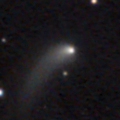
|
Now it is 13.7 mag (Apr. 18, Taras Prystavski). It keeps 14 mag for a long time until 2014 summer. It keeps observable in good condition in the Northern Hemisphere. It keeps unobservable after this in the Southern Hemisphere.
Date(TT) R.A. (2000) Decl. Delta r Elong. m1 Best Time(A, h)
May 17 5 21.96 62 4.2 2.220 1.696 46 14.0 20:36 (150, 25)
May 24 5 57.66 64 13.5 2.228 1.717 47 14.1 20:44 (152, 26)
|

|
It brightened up to 11-12 mag in 2012. Now it is 14.5 mag (Apr. 30, Sandor Szabo). It will be observable in good condition at 14 mag until 2014 early summer.
Date(TT) R.A. (2000) Decl. Delta r Elong. m1 Best Time(A, h)
May 17 12 2.31 -8 19.4 6.906 7.566 127 14.1 20:36 ( 5, 46)
May 24 11 58.89 -7 55.7 7.043 7.602 120 14.2 20:44 ( 19, 45)
|

|
Now it is very bright as 12.9 mag (Apr. 30, Taras Prystavski). It brightened up to 9 mag at the discovery in 2005. It will approach to the sun down to 0.8 a.u. on May 29. However, it will brighten up to 13-14 mag at best. In this apparition, it keeps observable in the morning sky all through the period. But it locates extremely low around the perihelion passage in the Northern Hemisphere.
Date(TT) R.A. (2000) Decl. Delta r Elong. m1 Best Time(A, h)
May 17 0 20.21 0 11.9 0.956 0.850 51 14.3 3:16 (275, 7)
May 24 0 56.17 3 16.4 1.014 0.831 48 14.2 3:09 (270, 6)
|
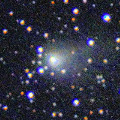
|
First return of a new periodic comet discovered in 1998. It brightened up to 10 mag at the discovery. Now it is 13.3 mag (Apr. 30, Sandor Szabo). A bit fainter than originally expected. But in the Northern Hemisphere, it keeps observable in excellent condition from autumn to spring. It locates somewhat low in the Southern Hemisphere.
Date(TT) R.A. (2000) Decl. Delta r Elong. m1 Best Time(A, h)
May 17 8 15.80 11 53.7 2.419 2.242 67 14.4 20:36 ( 82, 31)
May 24 8 28.35 10 40.1 2.504 2.261 64 14.6 20:44 ( 85, 26)
|

|
Now it is bright as 13.1 mag (May 7, Taras Prystavski). It keeps 13-14 mag and observable in good condition in the Northern Hemisphere for a long time from 2013 to 2014. In the Southern Hemisphere, it is not observable until 2014 autumn.
Date(TT) R.A. (2000) Decl. Delta r Elong. m1 Best Time(A, h)
May 17 1 13.34 51 44.6 4.367 3.686 42 14.6 3:16 (222, 24)
May 24 1 16.51 51 49.6 4.361 3.709 44 14.7 3:09 (224, 26)
|
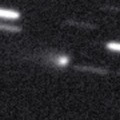
|
Now it is 14.9 mag (Apr. 18, Taras Prystavski). It is expected to brighten up to 5 mag in 2014 autumn. Now it is not observable. It will be observable again in July in the Southern Hemisphere, or in August in the Northern Hemisphere.
Date(TT) R.A. (2000) Decl. Delta r Elong. m1 Best Time(A, h)
May 17 5 1.04 17 56.3 3.331 2.411 20 14.9 20:36 (115, -4)
May 24 5 4.74 17 44.4 3.279 2.316 15 14.7 20:44 (120,-10)
|

|
Now it is 13.3 mag and already visible visually (May 3, Seiichi Yoshida). It is expected to brighten up to 13 mag and to be observable in good condition in 2015. In 2014, it keeps observable in good condition from winter to summer.
Date(TT) R.A. (2000) Decl. Delta r Elong. m1 Best Time(A, h)
May 17 13 39.11 0 29.9 3.660 4.531 145 14.9 21:59 ( 0, 55)
May 24 13 37.21 0 41.4 3.682 4.492 138 14.9 21:29 ( 0, 56)
|

|
Big asteroid discovered in 1906. It suddenly showed the cometary activity on Dec. 11, 2010, probably due to an impact of a small object. It has already turned to be stellar.
Date(TT) R.A. (2000) Decl. Delta r Elong. m1 Best Time(A, h)
May 17 2 52.59 10 24.2 4.314 3.338 13 15.1 3:16 (243,-17)
May 24 3 1.48 11 12.3 4.296 3.343 17 15.1 3:09 (245,-14)
|
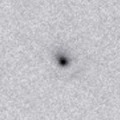
|
Now it is not observable. In the Northern Hemisphere, it will appear in the morning sky in late July. Then it will be observable at 12-13 mag in excellent condition from 2014 summer to 2015 spring. In the Southern Hemisphere, it will locate low around the highlight.
Date(TT) R.A. (2000) Decl. Delta r Elong. m1 Best Time(A, h)
May 17 3 25.75 18 4.4 3.424 2.414 2 15.4 3:16 (232,-18)
May 24 3 39.76 19 9.3 3.388 2.382 5 15.2 3:09 (232,-16)
|
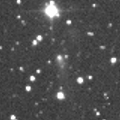
|
Now it is 15.2 mag (Apr. 22, Taras Prystavski), brighter than origianlly predicted. It will be observable at 14-16 mag for a long time from 2013 to 2014.
Date(TT) R.A. (2000) Decl. Delta r Elong. m1 Best Time(A, h)
May 17 16 5.10 -25 19.0 3.164 4.165 170 15.7 0:29 ( 0, 30)
May 24 16 0.88 -25 16.9 3.170 4.180 175 15.7 23:52 ( 0, 30)
|

|
Brightening rapidly. Now it is 15.7 mag (Apr. 22, Taras Prystavski). It will start fading after June, and will be fainter than 18 mag in August.
Date(TT) R.A. (2000) Decl. Delta r Elong. m1 Best Time(A, h)
May 17 13 55.60 -13 55.9 1.178 2.142 155 16.3 22:15 ( 0, 41)
May 24 13 51.24 -14 50.2 1.212 2.141 148 16.4 21:43 ( 0, 40)
|
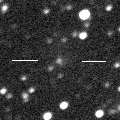
|
Now it is 17.9 mag (Mar. 9, W. Hasubick). Distant object, but it keeps observable at 14 mag for a long time from 2015 to 2016.
Date(TT) R.A. (2000) Decl. Delta r Elong. m1 Best Time(A, h)
May 17 19 20.68 -2 27.7 6.510 7.100 122 16.6 3:16 (349, 52)
May 24 19 19.94 -2 16.0 6.393 7.067 128 16.5 3:09 (358, 53)
|

|
It brightened up to 14.0 mag from spring to summer in 2013 (June 11, Sandor Szabo). Now it is 15.7 mag, much brighter than origianlly predicted (Apr. 24, Taras Prystavski). In the Northern Hemisphere, it will be observable at 15-16 mag in excellent condition until spring. It locates somewhat low in the Southern Hemisphere.
Date(TT) R.A. (2000) Decl. Delta r Elong. m1 Best Time(A, h)
May 17 11 39.26 36 30.4 4.379 4.686 101 16.6 20:36 (103, 82)
May 24 11 34.48 36 34.8 4.533 4.728 94 16.8 20:44 (101, 74)
|

|
Now it is 16.5 mag (Apr. 16, Taras Prystavski). It keeps 17 mag for a long time from 2014 to 2015. It is observable in excellent condition in the Northern Hemisphere. It is observable only until 2014 summer in the Southern Hemisphere.
Date(TT) R.A. (2000) Decl. Delta r Elong. m1 Best Time(A, h)
May 17 16 2.26 30 47.0 3.449 4.166 129 16.9 0:25 ( 0, 86)
May 24 15 57.99 32 2.6 3.451 4.143 127 16.9 23:49 ( 0, 87)
|
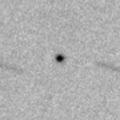
|
Now it is 16.1 mag (May 5, Taras Prystavski). It is expected to brighten up to 4-5 mag from autumn to winter in 2015. It already locates high in the Southern Hemisphere. It will be getting higher gradually also in the Northern Hemisphere. It is observable in good condition in the Southern Hemisphere until the highlight, or in the Northern Hemisphere after the highlight.
Date(TT) R.A. (2000) Decl. Delta r Elong. m1 Best Time(A, h)
May 17 23 58.91 -11 21.0 7.072 6.644 61 17.0 3:16 (287, 4)
May 24 0 0.62 -11 26.3 6.903 6.582 67 16.9 3:09 (290, 8)
|

|
It approached to the earth down to 0.68 a.u. in spring, and brightened up to 15.6 mag (Mar. 29, Taras Prystavski). Now it is fading. It has already faded down to 17.4 mag (May 3, P.-J. Dekelver). It will be fainter than 18 mag in June.
Date(TT) R.A. (2000) Decl. Delta r Elong. m1 Best Time(A, h)
May 17 10 39.05 -13 46.2 1.049 1.683 109 17.0 20:36 ( 29, 36)
May 24 10 44.57 -16 10.0 1.122 1.698 105 17.2 20:44 ( 36, 30)
|
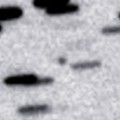
|
Now it is 16.1 mag (May 2, Mt. Lemmon Survey). It keeps 17-18 mag for a long time from 2014 to 2016.
Date(TT) R.A. (2000) Decl. Delta r Elong. m1 Best Time(A, h)
May 17 14 4.40 -11 32.3 4.688 5.633 157 17.1 22:23 ( 0, 43)
May 24 13 56.00 -11 17.8 4.729 5.617 148 17.1 21:47 ( 0, 44)
|

|
Now it is 17.5 mag (Apr. 5, N. James). It keeps observable at 18 mag for a long time from 2013 to 2016. It keeps locating high in the Northern Hemisphere. It keeps locating very low in the Southern Hemipshere.
Date(TT) R.A. (2000) Decl. Delta r Elong. m1 Best Time(A, h)
May 17 18 53.64 45 51.7 6.229 6.495 100 17.1 3:16 (180, 79)
May 24 18 46.89 47 2.2 6.190 6.490 102 17.1 2:42 (180, 78)
|

|
Now it is 18.0 mag (Apr. 30, Taras Prystavski). It was observed at 17.5 mag in early 2013. It will be observable at 17.5 mag again from spring to summer in 2014.
Date(TT) R.A. (2000) Decl. Delta r Elong. m1 Best Time(A, h)
May 17 19 43.90 -12 34.4 2.198 2.840 119 17.2 3:16 (344, 41)
May 24 19 44.69 -12 37.4 2.139 2.858 126 17.2 3:09 (350, 42)
|

|
Now it is 18.2 mag (Apr. 22, D. Herald). It keeps 17-18 mag for a long time from 2013 to 2014. It is observable in excellent condition in the Southern Hemisphere. It is not observable in the Northern Hemisphere.
Date(TT) R.A. (2000) Decl. Delta r Elong. m1 Best Time(A, h)
May 17 11 20.52 -56 14.2 4.105 4.701 120 17.3 20:36 ( 8, -2)
May 24 11 9.97 -55 8.5 4.167 4.707 116 17.3 20:44 ( 14, -3)
|
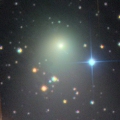
|
It became much brighter than expected, and reached up to 8.5 mag (Aug. 15, Alexandre Amorim). Now it is fading rapidly. It has already faded down to 17.5 mag (Apr. 23, K. Hills). In the Southern Hemisphere, it will keep observable in good condition for a long time until 2014 summer when the comet fades out. It will never be observable again in the Northern Hemisphere.
Date(TT) R.A. (2000) Decl. Delta r Elong. m1 Best Time(A, h)
May 17 15 12.46 -68 9.4 2.975 3.717 130 17.4 23:31 ( 0,-13)
May 24 14 59.07 -66 34.3 3.022 3.785 132 17.6 22:51 ( 0,-11)
|
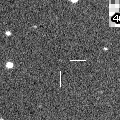
|
First return of a new periodic comet which brightened up to 13 mag in 2007. It was expected to brighten up to 13 mag again and observable in good condition from summer to autumn in 2014. But actually, it is 17.5 mag, much fainter than expected (Apr. 28, Taras Prystavski). It will be 16 mag at best actually.
Date(TT) R.A. (2000) Decl. Delta r Elong. m1 Best Time(A, h)
May 17 22 30.36 -6 41.8 2.386 2.408 79 17.6 3:16 (298, 24)
May 24 22 40.49 -6 4.8 2.292 2.394 83 17.5 3:09 (300, 27)
|
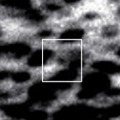
|
It is predicted to keep 16-17 mag for a long time from 2014 summer to early 2016. However, now it is 20.5 mag, much fainter than predicted (May 1, A. Maury, J.-G. Bosch, J.-F. Soulier, T. Noel).
Date(TT) R.A. (2000) Decl. Delta r Elong. m1 Best Time(A, h)
May 17 17 27.87 -27 48.2 2.105 3.039 152 17.9 1:51 ( 0, 27)
May 24 17 23.33 -27 40.9 2.037 3.009 160 17.7 1:19 ( 0, 27)
|

|
Now it is 17.9 mag (Apr. 6, Ken-ichi Kadota). It keeps 17 mag for a long time until 2015.
Date(TT) R.A. (2000) Decl. Delta r Elong. m1 Best Time(A, h)
May 17 10 48.69 -5 36.1 2.971 3.443 109 17.7 20:36 ( 31, 44)
May 24 10 51.23 -5 28.1 3.050 3.429 103 17.8 20:44 ( 41, 41)
|

|
Now it is 17.1 mag (Apr. 14, A. Maury, J.-G. Bosch, T. Noel, J.-F. Soulier). It keeps 17-18 mag until June.
Date(TT) R.A. (2000) Decl. Delta r Elong. m1 Best Time(A, h)
May 17 18 45.25 -18 33.7 1.266 2.106 134 17.7 3:08 ( 0, 36)
May 24 18 42.46 -18 29.0 1.246 2.138 142 17.8 2:38 ( 0, 37)
|

|
First return of a new periodic comet discovered in 2005. It was expected to be observable at 17 mag for a long time from 2013 to 2014. However, it has not been recovered yet. Actually, it is much fainter than predicted, fainter than 20 mag (Aug. 6, Jean-Francois Soulier).
Date(TT) R.A. (2000) Decl. Delta r Elong. m1 Best Time(A, h)
May 17 22 41.05 -8 41.8 3.317 3.249 77 17.8 3:16 (298, 21)
May 24 22 47.13 -8 17.1 3.229 3.256 82 17.8 3:09 (300, 24)
|

|
Now it is 17.8 mag (Apr. 26, A. Maury, J.-F. Soulier). It has brightened in outburst up to 14 mag twice, in 2006 January and 2011 May. It will pass the perihelion in 2015. It keeps observable at 17 mag for a long time after this.
Date(TT) R.A. (2000) Decl. Delta r Elong. m1 Best Time(A, h)
May 17 21 16.83 -12 27.5 5.816 6.041 98 17.9 3:16 (318, 32)
May 24 21 18.23 -12 19.2 5.700 6.032 104 17.8 3:09 (322, 34)
|
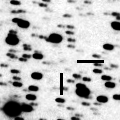
|
Now it is 18.5 mag (Mar. 31, Hidetaka Sato). It is observable at 18 mag in good condition from spring to summer.
Date(TT) R.A. (2000) Decl. Delta r Elong. m1 Best Time(A, h)
May 17 21 8.09 -2 27.5 1.548 1.948 96 17.8 3:16 (313, 41)
May 24 21 13.42 0 9.3 1.502 1.969 101 17.8 3:09 (315, 45)
|
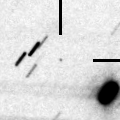
|
Now it is 18.3 mag (May 2, K. Hills). It keeps 18 mag from spring to summer. It is observable in good condition in the Southern Hemisphere. It is not observable in the Northern Hemisphere.
Date(TT) R.A. (2000) Decl. Delta r Elong. m1 Best Time(A, h)
May 17 17 5.22 -64 49.8 0.680 1.551 131 17.9 1:29 ( 0,-10)
May 24 16 55.71 -63 15.8 0.698 1.593 136 17.9 0:52 ( 0, -8)
|

|
It brightened up to 12-13 mag from 2012 to 2013. It has already gone away. But it keeps 18 mag for a while, and it will be observable in good condition in the Southern Hemisphere. It will be getting higher gradually also in the Northern Hemisphere.
Date(TT) R.A. (2000) Decl. Delta r Elong. m1 Best Time(A, h)
May 17 0 17.82 -13 37.1 4.127 3.699 58 17.9 3:16 (286, -1)
May 24 0 24.54 -13 14.6 4.061 3.717 63 17.9 3:09 (288, 2)
|
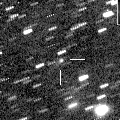
|
Now it is 17.6 mag (May 10, Taras Prystavski). It keeps 18 mag for a long time from 2013 to 2014.
Date(TT) R.A. (2000) Decl. Delta r Elong. m1 Best Time(A, h)
May 17 15 54.17 18 8.5 6.707 7.533 142 17.9 0:18 ( 0, 73)
May 24 15 48.78 18 45.8 6.729 7.537 140 17.9 23:40 ( 0, 74)
|

|
Now it is 18.1 mag (Mar. 29, M. Jaeger, W. Vollmann, E. Prosperi, S. Prosperi). It keeps 18 mag for a very long time from 2013 to 2018. It locates high in the Southern Hemisphere. But it locates somewhat low in the Northern Hemisphere.
Date(TT) R.A. (2000) Decl. Delta r Elong. m1 Best Time(A, h)
May 17 10 55.53 -16 12.2 8.838 9.297 114 17.9 20:36 ( 24, 35)
May 24 10 55.98 -15 56.7 8.931 9.292 107 17.9 20:44 ( 33, 32)
|

|
Now it is 19.4 mag (May 3, A. Waszczak). First return of a new periodic comet which brightened up to 13 mag in outburst in 2008. It will be observable in good condition from spring to summer. However, it will be only 19-20 mag at best in this apparition.
Date(TT) R.A. (2000) Decl. Delta r Elong. m1 Best Time(A, h)
May 17 12 10.39 14 13.1 1.771 2.437 119 19.5 20:36 ( 4, 69)
May 24 12 11.75 13 23.2 1.831 2.426 113 19.6 20:44 ( 25, 66)
|
|
![]()
![]()














































